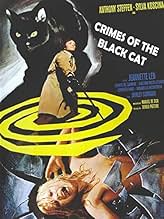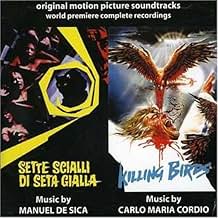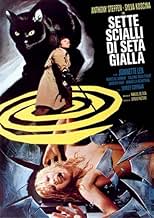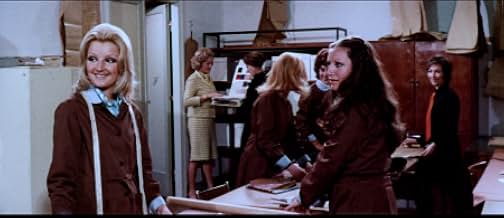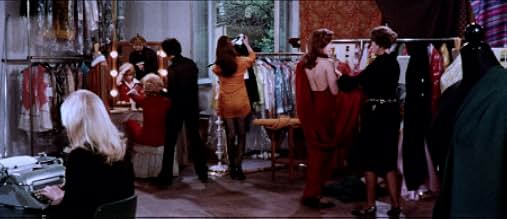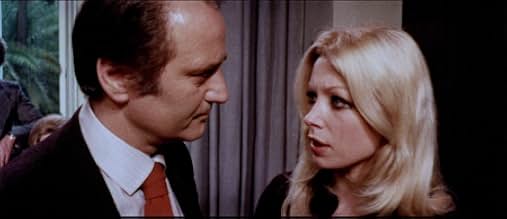CALIFICACIÓN DE IMDb
6.1/10
1.1 k
TU CALIFICACIÓN
Agrega una trama en tu idiomaA blind pianist overhears a conversation in a nightclub, and is determined to figure out who is responsible for a string of strange murders involving a black cat.A blind pianist overhears a conversation in a nightclub, and is determined to figure out who is responsible for a string of strange murders involving a black cat.A blind pianist overhears a conversation in a nightclub, and is determined to figure out who is responsible for a string of strange murders involving a black cat.
- Dirección
- Guionistas
- Elenco
Giovanna Lenzi
- Susan Leclerc
- (as Jeannette Len)
Isabelle Marchall
- Paola Whitney
- (as Isabelle Marchal)
Lorenzo Piani
- Waiter in Hamburg
- (solo créditos)
Bruno Alias
- Hairdresser
- (sin créditos)
Francesco Anniballi
- Male Nurse
- (sin créditos)
Florinda Bolkan
- Carol Hammond
- (material de archivo)
- (sin créditos)
Margherita Horowitz
- Atelier personnel
- (sin créditos)
Opiniones destacadas
De Sica's below-average score notwithstanding (and they do count a lot in these movies, don't they?) this is a satisfying giallo with all the key elements included and none of them bungled. Granted, a lot of those key elements are ripped right from other movies, and the direct influence of Psycho, Black Belly of the Tarantula, Blood and Black Lace, Lizard in a Woman's Skin and most of all Cat O'Nine Tails doesn't win it points for creativity, but it's all handled as though it were the first film ever made so you don't really mind. The plot, with its typically and gloriously dumb motive for the killings (in this case a car crash in the past, as was the case with Seven Orchids Stained in Blood) moves along at a fair pace, and making the hero blind gives him a sympathetic attraction most giallo heroes lack. It's not as good as any of the films from which it's descended but nevertheless a solid entry in the genre.
The Crimes of the Black Cat is a pretty typical Giallo, which takes influence from many of the more established genre classics. The central character is blind, which is an idea lifted from Argento's 'The Cat o'Nine Tails', and the style and plotting is clearly reminiscent of Argento's early work. The black cat is an animal often seen in horror films, and that's down to Edgar Allen Poe and his famous story about the ominous animal. The way that the cat is used in this film is good because it's instrumental to the plot (unlike other Giallo's which mention a cat in the title and barely even feature one), but it really has to be said that the modus operandi used by the murderer is completely ridiculous even for a Giallo. The plot focuses on Peter Oliver; a blind, yet rich man who finds himself at the centre of a murder investigation when his girlfriend is killed. It seems that someone has a grudge against some of the local fashion models, and all the murders have the common theme of a yellow shawl being found next to the dead victims. But how do you catch a murderer that you cannot see?
Director Sergio Pastore, while taking many themes from across the Giallo genre, hasn't decided to make the film as bloody as some of its counterparts. The murder weapon doesn't allow for too much of the red stuff, but even so; it comes as a huge shock at the end when this placid film explodes with a Psycho-style shower sequence that features some of the most disgusting gore in the entire Giallo genre; and almost makes up for the lack of blood in the rest of the film. There is a lot of sleaze in the movie, however, and this is shown through ideas such as lesbianism and drug use; and that in turns blends well with the depressing urban climate in which the movie takes place. The acting is nothing special, but it's not bad in Giallo terms. Antonio De Teffè does well in the lead role and succeeds at convincing us he is actually blind. There are no real stars in the film beside him, and the lack of a heroine doesn't do the film too many favours either. Overall, this is a rather strange entry in the Giallo cycle as it has a number of good and inventive moments; but it's all encased around a lot of borrowing and tributes. Still, i wouldn't hesitate to rate this film as a success and it comes recommended to Giallo fans!
Director Sergio Pastore, while taking many themes from across the Giallo genre, hasn't decided to make the film as bloody as some of its counterparts. The murder weapon doesn't allow for too much of the red stuff, but even so; it comes as a huge shock at the end when this placid film explodes with a Psycho-style shower sequence that features some of the most disgusting gore in the entire Giallo genre; and almost makes up for the lack of blood in the rest of the film. There is a lot of sleaze in the movie, however, and this is shown through ideas such as lesbianism and drug use; and that in turns blends well with the depressing urban climate in which the movie takes place. The acting is nothing special, but it's not bad in Giallo terms. Antonio De Teffè does well in the lead role and succeeds at convincing us he is actually blind. There are no real stars in the film beside him, and the lack of a heroine doesn't do the film too many favours either. Overall, this is a rather strange entry in the Giallo cycle as it has a number of good and inventive moments; but it's all encased around a lot of borrowing and tributes. Still, i wouldn't hesitate to rate this film as a success and it comes recommended to Giallo fans!
Stop me if you've heard this one before (don't really though) - a black hatted, gloved killer is working his way through the models at a fashion house. Blind composer Anthony Steffan gets caught up in all this nonsense because the first victim is his girlfriend Paola, who about ten seconds previously, dumped the poor guy by letter. That's right - a blind guy, dumped by letter.
Add to that the strange conversation Anthony overhears in his local bar. Someone seems to be blackmailing someone else to do something, but then an annoying hippy throws on a 'groovy' record to 'freak out' to, and Anthony only hears about half the conversation. The waiter describes a woman in a white cape to Anthony, but the other conversationalist must have slipped out a back door, because the waiter didn't seem them. Can I add here however that the record lasts about fifty seconds. Thank God it wasn't some prog or something.
The next day Paola is found dead at the fashion house. It's a kind of locked room mystery, as no one else was there, she has a slight scratch on her face, and there's a yellow shawl lying nearby. Model Margot swears there was a basket in the room too, but that's disappeared. The annoying police, plus Anthony (with sidekick butler Umberto Raho in tow) get right on the case.
There's plenty of suspects too, from hunky Giacomo Rossi-Stuart, second in command at the fashion house and a fanny rat to boot, then there's his missus, the boss of the place. There's also your usual lesbians involved, some gossips, slags, blackmailers. You know the drill by now.
Anthony maybe be blind, but he's no fool. He's one step in front of the police, but one step behind the killer, and what's his dead girlfriend doing in supposed blackmail pictures with Giacomo Rossi-Struart? Someone else gets the old yellow shawl/scratch killing, and Giacomo gets closer to the killer, or at least the person being forced to set up these killings - using his sense of smell!
Sure it's derivative of Mario Bava's Blood and Black Lace (the fashion house) and Argento's Bird With A Crystal Plumage (with the tape recorded clue, and Umberto Raho), there's still loads to enjoy here. There's a great colour scheme (mostly yellow of course!) and Anthony's character is composing the soundtrack to a giallo! When you see footage of it, you'll notice it's Lucio Fulci's Lizard In A Woman's Skin, and as an added bonus, it's the bit that reveals the killer. Good work there.
There's the scene where a character leads Anthony to an glass recycling plant (I think...in 1972?) and leaves him to injure himself amongst all the glass and sudden drops, and a razor killing in a shower that takes the gore level way beyond anything else seen prior to it in the film. The Copenhagen setting is different from the norm too.
Add to that the strange conversation Anthony overhears in his local bar. Someone seems to be blackmailing someone else to do something, but then an annoying hippy throws on a 'groovy' record to 'freak out' to, and Anthony only hears about half the conversation. The waiter describes a woman in a white cape to Anthony, but the other conversationalist must have slipped out a back door, because the waiter didn't seem them. Can I add here however that the record lasts about fifty seconds. Thank God it wasn't some prog or something.
The next day Paola is found dead at the fashion house. It's a kind of locked room mystery, as no one else was there, she has a slight scratch on her face, and there's a yellow shawl lying nearby. Model Margot swears there was a basket in the room too, but that's disappeared. The annoying police, plus Anthony (with sidekick butler Umberto Raho in tow) get right on the case.
There's plenty of suspects too, from hunky Giacomo Rossi-Stuart, second in command at the fashion house and a fanny rat to boot, then there's his missus, the boss of the place. There's also your usual lesbians involved, some gossips, slags, blackmailers. You know the drill by now.
Anthony maybe be blind, but he's no fool. He's one step in front of the police, but one step behind the killer, and what's his dead girlfriend doing in supposed blackmail pictures with Giacomo Rossi-Struart? Someone else gets the old yellow shawl/scratch killing, and Giacomo gets closer to the killer, or at least the person being forced to set up these killings - using his sense of smell!
Sure it's derivative of Mario Bava's Blood and Black Lace (the fashion house) and Argento's Bird With A Crystal Plumage (with the tape recorded clue, and Umberto Raho), there's still loads to enjoy here. There's a great colour scheme (mostly yellow of course!) and Anthony's character is composing the soundtrack to a giallo! When you see footage of it, you'll notice it's Lucio Fulci's Lizard In A Woman's Skin, and as an added bonus, it's the bit that reveals the killer. Good work there.
There's the scene where a character leads Anthony to an glass recycling plant (I think...in 1972?) and leaves him to injure himself amongst all the glass and sudden drops, and a razor killing in a shower that takes the gore level way beyond anything else seen prior to it in the film. The Copenhagen setting is different from the norm too.
One thing you can say about Italian gialli: they never resort to killing someone with a simple shooting or stabbing--the villains always use some ridiculously elaborate Rube Goldberg method for doing their victims in. And this giallo features what might be the most ridiculous of them all. I don't want to give too much away, but I will say that the English title "Crimes of the Black Cat" can be taken completely literally. (Obviously, the people who thought up this movie were not cat owners--have you ever tried to get a cat to do ANYTHING?). Aside from the especially absurd murders this is a typical giallo. It is set in the European fashion world, it's highly stylized, the plot makes little sense, and the motivation of the villain turns out to be even more ludicrous than the method of murder.
The protagonist is the blind male lover of the first murder victim. (How come blind people never complain that they are always being stereotyped as good-looking and resourceful individuals who always get to solve the crime and sleep with many attractive members of the opposite sex along the way?). The only name star is Sylva Koscina, but she is barely in the movie. The best actor though is the cat (perhaps the self-same feline thespian who played "Satan" in "Gently, Before She Dies"). After he exits the film, it quickly spirals downward with a truly tasteless shower murder and one of those abrupt freeze-frame endings that were so big in the 70's (maybe they ran out of film a lot back then). If you like gialli at all though, you'll probably like this one. It's very typical for its kind.
The protagonist is the blind male lover of the first murder victim. (How come blind people never complain that they are always being stereotyped as good-looking and resourceful individuals who always get to solve the crime and sleep with many attractive members of the opposite sex along the way?). The only name star is Sylva Koscina, but she is barely in the movie. The best actor though is the cat (perhaps the self-same feline thespian who played "Satan" in "Gently, Before She Dies"). After he exits the film, it quickly spirals downward with a truly tasteless shower murder and one of those abrupt freeze-frame endings that were so big in the 70's (maybe they ran out of film a lot back then). If you like gialli at all though, you'll probably like this one. It's very typical for its kind.
(aka: THE CRIMES OF THE BLACK CAT)
Filmed in Denmark with a largely Italian cast in a setting away from the usual Italian locations for this genre. So forget that these people are Danes speaking Italian. You can't be too specific with a film like this.
OK so you've seen this before and if you've seen BLOOD AND BLACK LACE, then you'll know how it turns out. Even so, this really isn't bad watching and the story is constructed well despite a couple of suspense contrivances for the audience like footsteps approaching a door, expecting the viewer to believe it's the killer when it turns out to be the hotel bellboy delivering breakfast.
Blind composer Peter Oliver (spaghetti western star, Anthony Steffen) helps sleuth the murders of fashion models in swanky Copenhagen after his close friend Paola is murdered. He suspects something is wrong when he overhears a conversation about a crime in a restaurant while waiting for Paola to show up. She never does. It turns out Paola is blackmailing Victor (Giacomo Rossi-Stuart), threatening to expose some incriminating photographs to his wife (Sylvia Koscina).
Of course when it comes to this genre, the murders can't always be done in a straightforward way and one particular device is using a black cat who's hands are dipped in curare, scratching the victims and causing them to have heart attacks. Strange, yes, but that's typical of the genre so one has to suspend disbelief if you want to watch films like this.
I won't reveal who the name of the killer is. You'll have to see that for yourself, but I will say that it ends in one of those typical freeze-frame endings that were popular in the 1970s.
The DVD by Degored is of poor quality, taken from videotape source with dropouts appearing occasionally and muffled sound, although the subtitles in English look pretty accurate.
There are worse out there.
5 out of 10
Filmed in Denmark with a largely Italian cast in a setting away from the usual Italian locations for this genre. So forget that these people are Danes speaking Italian. You can't be too specific with a film like this.
OK so you've seen this before and if you've seen BLOOD AND BLACK LACE, then you'll know how it turns out. Even so, this really isn't bad watching and the story is constructed well despite a couple of suspense contrivances for the audience like footsteps approaching a door, expecting the viewer to believe it's the killer when it turns out to be the hotel bellboy delivering breakfast.
Blind composer Peter Oliver (spaghetti western star, Anthony Steffen) helps sleuth the murders of fashion models in swanky Copenhagen after his close friend Paola is murdered. He suspects something is wrong when he overhears a conversation about a crime in a restaurant while waiting for Paola to show up. She never does. It turns out Paola is blackmailing Victor (Giacomo Rossi-Stuart), threatening to expose some incriminating photographs to his wife (Sylvia Koscina).
Of course when it comes to this genre, the murders can't always be done in a straightforward way and one particular device is using a black cat who's hands are dipped in curare, scratching the victims and causing them to have heart attacks. Strange, yes, but that's typical of the genre so one has to suspend disbelief if you want to watch films like this.
I won't reveal who the name of the killer is. You'll have to see that for yourself, but I will say that it ends in one of those typical freeze-frame endings that were popular in the 1970s.
The DVD by Degored is of poor quality, taken from videotape source with dropouts appearing occasionally and muffled sound, although the subtitles in English look pretty accurate.
There are worse out there.
5 out of 10
¿Sabías que…?
- TriviaAnthony Steffen was dubbed by Edmund Purdom for the English language version.
- ErroresAfter the cat lady's death, the newspaper headline misspells "mystery", as in "The mistery (sic) of the black cat still goes on."
- ConexionesFeatures Un reptil con piel de mujer (1971)
Selecciones populares
Inicia sesión para calificar y agrega a la lista de videos para obtener recomendaciones personalizadas
- How long is The Crimes of the Black Cat?Con tecnología de Alexa
Detalles
- Fecha de lanzamiento
- País de origen
- Idioma
- También se conoce como
- The Crimes of the Black Cat
- Locaciones de filmación
- Copenhague, Dinamarca(location)
- Productoras
- Ver más créditos de la compañía en IMDbPro
- Tiempo de ejecución1 hora 39 minutos
- Mezcla de sonido
- Relación de aspecto
- 2.35 : 1
Contribuir a esta página
Sugiere una edición o agrega el contenido que falta

